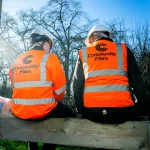The Safety and Build Challenges of UK Fibre Broadband Rollouts

Whilst the ‘Church of Full Fibre‘ is now operating a broader admissions policy (cable and 5G are both firmly welcome) the race to build Full Fibre Britain is well and truly on. With around thirty operators planning or actively building, there are real ‘first mover’ advantages for the fleet -footed operator.
The challenge for the fibre industry is how these scale civil engineering programmes (because that’s what they are) can be delivered efficiently and maintain a focus on health and safety (H&S). The recent death of a 35-year-old sub-contractor working on behalf of a major operator is a timely and sobering reminder of the consequences when things go wrong.
When things go wrong
‘Homes passed’ and the ‘cost per home passed’ are the common metrics investors use to judge the performance of the organisations they have invested in. With such focus, the temptation to cut corners and target easier to deliver locations whilst leaving more challenging and expensive builds for later, can be irresistible.
Advertisement
We have already seen the consequences of poorly managed projects. Devon & Somerset’s fibre programme resulted in contract termination after a traumatic delivery process with the customer identifying “fundamental issues, including management of sub-contractors, build methodology and capacity within the team” as the root cause. This is not an isolated case as regular ISP Review readers will be only too well aware. A successful Fibre build depends on a lot more than pace.
Much of the physical construction work is sub-contracted out to specialist Tier 1 & 2 civils companies like Kier or Morrison. But it is important to note that sub-contracting the work does not necessarily mean subcontracting all the responsibilities – and health and safety is one of those responsibilities that has implications at all stages of the supply chain.
Where does responsibility lie?
Fibre operators need to recognise they hold key statutory Duty Holding roles. ‘Throwing H&S over the fence’ to the contractor working on site is not acceptable – or legal – but unfortunately is still an attitude that is often seen in the industry today. The Health and Safety Executive would want to see evidence of safety issues being considered right from programme concept stage and actively reflected in the design and planning stage, for example, documented evidence that a cabinet location was changed to avoid an accident blackspot area.
If moral responsibility isn’t enough to motivate a heightened attention to H&S matters, then the financial penalties and reputational risk associated with non-compliance should be. Failure can lead to criminal conviction and fines of up to 10% of Group turnover, so H&S should be high on the corporate risk register. A major UK retailer was recently fined £733K when a customer slipped in a store and broke their hip. Even ‘no harm’ incidents are now attracting fines of several hundred thousand Pounds.
Advertisement
Like a lot of industries, telecoms providers have not fully appreciated the implications of the 2015 changes to the Construction (Design Management) regulations (CDM). One of the key changes was the much broader definition of what constitutes ‘construction’, which has now been extended beyond the stereotypical interpretation to include any work that ‘interacts’ with the fabric of a building or structure. So CDM has potential implications even for operators looking to connect homes within a blocks of flats, for instance.
Operators may be unsure about which of the roles defined in CDM is the appropriate one for them. The outcome is often for operators to blur the responsibilities of ‘Client’, ‘Principal Designer’, and ‘Principal Contractor’, which effectively makes the operator responsible for risk mitigation strategies and takes safety responsibilities down to the individual site level when that responsibility should properly sit with the sub-contractor. This can lead to overlapping and confused responsibilities with the potential for gaps to open up, the lack of appropriate control and understanding leading to potential serious incidents. A key change in the 2015 regulations was to hold the client accountable for H&S on the entire project lifecycle, a duty that cannot be delegated down or contracted out to the supply chain. A major UK business was fined £300K for failing in its Client responsibilities when a sub-contractor employee fell through the skylight of a building. Legal fees and corrective actions across the whole estate means that the fine is just the tip of the cost iceberg.
Commercial Engagement Models
A carefully thought out CDM approach is only one dimension of sub-contractor engagement. Commercial engagement models are another area fraught with risk. The simple laws of supply and demand are at play in the civil engineering market. There is a finite supply of experienced civil engineering resource and over thirty planning or building.
The fibre industry isn’t the only industry digging holes; we are in the middle of rolling gas and water mains replacement programmes, both of which draw on the same resource pool. In short it is a seller’s market. Despite all this, the commercial strategy of many operators remains focussed on getting to the lowest price point rather than reflecting the sensitivity of the overarching business case to delays and disruption.
Advertisement
A victory on headline prices can often be Pyrrhic; civil engineering companies are rather good at recovering margin ceded during contract negotiations with a flood of variations or compensation events, not only reversing any cost benefit, but creating the additional overhead of processing numerous additional claims. Unlike the operators, this is their core business and the civils companies are very good at it.
Operators need to maintain focus on delivering their overarching fibre business case rather than managing civils costs as though it were an isolated activity. A mature approach will focus on delivering the overarching fibre case and be reflective of the fact that sub-contractors have choices which make mutually beneficial partnerships an essential success factor.
Delivering a successful programme
So far, I have concentrated narrowly on CDM and supplier management strategy. Whilst these two factors have significant implications for the overall success of the build programme, they are only two items on a long list of issues that need to be worked through as part of a successful delivery programme, and all these aspects should be viewed holistically rather than as separate issues.
For many build activities the ‘to do’ list is the result of bitter experience and corrective actions in the live environment, rather than upfront planning and Programme Management good practice. Every unforeseen item added to the list draws programme managers into the fire-fighting zone dealing with immediate deployment issues, reducing the opportunity of the programme team to significantly change the trajectory and outcomes of the programme.
For some, firefighting is the heroic face of programme management. In truth success should be about delivering tangible benefits to a predictable heartbeat. Effective programme control comes from investing time and effort at the planning stage and building an understanding of risks and the appropriate mitigations. Some operators are already triaging build plans for known risk factors, such as Section 58 dig restrictions and proximity to railways. This means that realistic expectations can be set and challenging builds given the focus they need, but this is far from the norm. A reliable build plan creates the stable reference point for resource and materials scheduling, completing the ‘virtuous circle’ of delivery.
My advice would be to invest heavily in thinking through your delivery programme, with a hearty slug of time devoted to defining the value and benefits sought. You may even have a build process that has worked well in the past , but are you confident that your current way of working can be reliably scaled to support new growth ambitions or are you already operating at your limits? Better to find out now rather than in the heat of delivery or past the point of no return.
– Mark Harrop – Telecom Practice Lead for Arcadis UK Plc.
Mark leads Arcadis' telecoms practice and has over 30 years of fixed and mobile telecoms industry experience working for a variety of operators including BT, NTL (now Virgin Media), Telstra and Energis. Find me on Linkedin.
« Openreach Reveals Price of New 0.5Mbps Fibre Broadband Tier
Ofcom Warns Major UK Broadband ISPs Over Charging for Email »























































“Homes passed’ and the ‘cost per home passed’” and putting the easy homes first.
Explains pretty much the whole NBN mess in Australia with its Multi-technology misfit failure.
In the begining NBN Co. was populated with too many square pegs in round holes staff members plus extravagant spending on providing their staff with top shelf vehicles and equipment. Budget blown far too soon.
Anyone following the Grenfell Tower enquiry will be only too familiar with the adverse effects of this game of Contractural Tennis:
“civil engineering companies are rather good at recovering margin ceded during contract negotiations with a flood of variations or compensation events, not only reversing any cost benefit, but creating the additional overhead of processing numerous additional claims. Unlike the operators, this is their core business and the civils companies are very good at it”
Just substitute “Council’s” for Operators.
This could be an opinion column on just about any industry. They all subcontract and they all should bear some responsibility for their subcontractor’s performance. Think of the oil & gas industry, tech hardware, water, roads, building…literally everything is most likely in some form subcontracted. It isn’t just for limiting liability either resourcing is often the big one. Companies are not built to recruit on the levels required of a project or they don’t have the business model to support the number of employees or the training of the needed employee type. I don’t disagree with the point made above but the nature of the subcontracting model is that you tend to get good and bad eggs and after they have been selected it tends to be a mixed bag. Mature companies rid themselves of the poor performers but when they must have a job completed they will often select who is ready and willing…nature of most industry.
When you are digging the roads rather than manufacturing in a factory, issues present themselves publically. There is no hiding and for major infrastructure projects the nature of the game is to widen your supplier base and go go go. Again I support the message of control but the reality is that risk is understood managed.